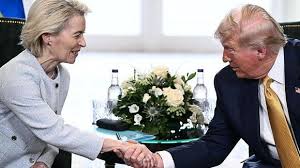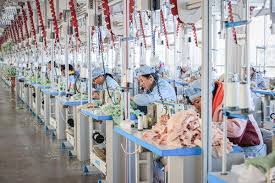By placing a 15% import duty on the majority of EU goods, which is half the feared rate, the U.S. and the European Union reached a framework trade agreement on Sunday, preventing a larger trade war between the two partners that account for about one-third of global trade.
Following months of discussions and an hour-long meeting, U.S. President Donald Trump and European Commission President Ursula von der Leyen announced the agreement at Trump’s opulent golf property in western Scotland.
Trump told reporters, “I think this is the biggest deal ever made,” while applauding the EU’s promises to invest around $600 billion in the US and significantly expand its purchases of US military hardware and energy.
After years of what he described as unfair treatment of U.S. exporters, Trump said the agreement, which comes after a $550 billion deal he inked with Japan last week, would deepen connections between the transatlantic powers.
Trump is a difficult negotiator, according to von der Leyen, who stated the 15% tax was “across the board” before assuring reporters it was “the best we could get.”
“The two biggest economies in the world have a trade agreement, and it is significant. It’s very important. Stability will result from it. It will provide consistency,” she said.
Although the agreement mostly reflects the framework agreement that the United States signed with Japan, it still leaves many issues unanswered, such as the tariff rates on spirits, a contentious issue for many people on both sides of the Atlantic.
If all the details hold, the deal, which Trump claimed calls for “hundreds of billions of dollars” in arms purchases and $750 billion in EU purchases of U.S. energy in the upcoming years, should be good news for several EU companies, including Novo Nordisk, Mercedes-Benz, and Airbus.
The agreement was hailed by German Chancellor Friedrich Merz, who said it prevented a trade war that would have severely impacted Germany’s export-based economy and its big auto industry.
German automakers Volkswagen, Mercedes, and BMW were among the most severely impacted by the current 27.5% U.S. duty on imports of automobiles and auto parts.
In contrast to Europe’s initial aspirations to negotiate a zero-for-zero tariff agreement; many Europeans will still view the baseline 15% tariff as excessive.
The European Parliament’s trade committee is chaired by German Social Democrat Bernd Lange, who claimed the tariffs were unfair and that the large EU investment intended for the United States would probably be paid for by the bloc itself.
A senior U.S. administration official told reporters Sunday night that Trump has the power to raise the tariffs in the future if European nations fail to fulfill their investment pledges.
Within an hour after the deal’s announcement, the euro increased by about 0.2% vs. the dollar, sterling, and yen.
THE JAPAN DEAL MIRROR
The agreement reached on Sunday, according to Teneo’s deputy director of research Carsten Nickel, was “merely a high-level, political agreement” that could not take the place of a carefully negotiated trade agreement:
“This, in turn, creates the risk of different interpretations along the way, as seen immediately after the conclusion of the U.S.-Japan deal.”
There are several exceptions to the tax, even though it applies to the majority of items, such as medications and semiconductors.
The United States will continue to impose a 50% tax on aluminum and steel.
Von der Leyen proposed a quota system as a substitute for the tariff; according to a senior administration official, EU leaders have requested that the two parties keep discussing the matter.
Both sides will not impose tariffs on aircraft and aviation parts, certain chemicals, some generic medications, semiconductor equipment, certain agricultural products, natural resources, and essential raw materials, according to von der Leyen.
While spirits were still being discussed, von der Leyen stated, “We will continue to work to add more products to this list.”
According to a U.S. official, there is a “reasonably good chance” that the parties will agree to a tariff rate lower than 15%, and the commercial aircraft tariff rate will stay at zero for the time being.
The parties will then decide together what to do after a U.S. review is finished.
There was no estimated completion date for that probe.
The agreement will be marketed as a victory for Trump, who wants to restructure the world economy and close long-standing trade deficits with the United States.
He has already reached similar framework agreements with Japan, Indonesia, Vietnam, and Britain, but his administration has fallen short of its “90 deals in 90 days” target.
Although EU officials indicated the specifics of those standards were still being discussed, U.S. officials said the EU had agreed to reduce non-tariff barriers for cars and certain agricultural exports.
During a briefing, a senior U.S. official told reporters,
“They are five times larger than Japan, and their economy is $20 trillion.”
“So the opportunity of opening their market is enormous for our farmers, our fishermen, our ranchers, all our industrial products, all our businesses.”
The EU was “formed to screw the United States” on trade, according to Trump’s frequent tirades against it.
The U.S. merchandise trade deficit with the EU, which reached $235 billion in 2024, according to U.S. Census Bureau data, has been the source of his ire for years.
The EU cites the U.S. service surplus as somewhat offsetting the imbalance.
Trump has dismissed academics’ concerns about the possibility of inflation and claimed that his tariffs are generating “hundreds of billions of dollars” in revenue for the United States.
After weeks of discussions failed to produce a comprehensive trade deal, Trump threatened on July 12 to impose a 30% tariff on EU imports, effective August 1.
If an agreement to prevent the duties could not be reached, the EU had prepared counter tariffs on $109 billion (approximately 93 billion euros) worth of U.S. goods.

















